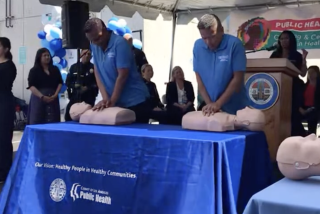Donor’s Hope: To Salute a Life by Saving Lives
- Share via
At a luncheon Saturday at San Clemente Hospital and Medical Center, Helena Jacobson thanked those who had supported her efforts to raise money for lifesaving devices called automatic external defibrillators (AEDs). But one thank you she added, her voice cracking, was special:
“We’re going to save lives because of you, honey.”
Most there knew whom she meant. Dr. Raymond Roberts Jacobson, who had been the hospital’s chief of emergency medicine, was Helena Jacobson’s husband. He died of sudden cardiac arrest in January at age 39.
Jacobson knew that only a few emergency response teams in her area carried AEDs, which can recharge the heart when someone has suffered cardiac arrest. So in the five weeks following her husband’s death, she set out to raise enough money to buy three of them. But her efforts were so successful, she wound up with $40,000, enough to buy 13 of the devices. One more was donated by the manufacturer and another by friends.
She didn’t hold fund raisers, she just started writing everyone she knew. “Our son Nickie licked the stamps and we’d send out letters everywhere,” she said. “Pretty soon I was asked to speak about it to community groups, where we raised more money.”
Saturday, she turned over 15 AEDs to San Clemente Mayor Scott Diehl. It was a symbolic gesture, because they won’t all go to the city. Some will be distributed to state beach lifeguards and deputy sheriffs.
Giving one to the municipal golf course was her husband’s idea.
Helena Jacobson, director of business development at the hospital, went to a meeting on AEDs late last year. She asked her husband for good places to put them. Don’t overlook golf courses and beaches, he told her. He emphasized how important they could be.
Raymond Jacobson was alone when he died. But if someone could have given him CPR, then an AED, his life might have been saved, his wife said.
Hospital officials say only 5% to 8% of those who suffer sudden cardiac arrest survive. But that number could double if an AED is available.
An AED is about the size of a briefcase. It includes a device that measures heart rhythms. If the rhythms require an electric shock, the device has a built-in voice that tells the operator whether to apply an electrical charge, which will defibrillate the heart. The voice adds, “Do not touch the patient!”
San Clemente Marine Safety Officer Steve Lashbrook says there are two reasons for the warning.
“If you’re touching the patient, the machine can’t measure the rhythms. But also, you can get shocked once the electrical discharge begins.”
Lashbrook and Steve Long, lifeguard chief for three state beaches in Orange County, said they welcome the AED contributions from Jacobson and her memorial committee members.
“It’s something we’ve needed, but they’re expensive, and the budget just hasn’t allowed for it,” Long said.
The AEDs cost about $3,500 each. Beginning in August, most CPR training will include instruction in AEDs.
Also on hand at Saturday’s luncheon were Irvin Blumenthal, an actor, accompanied by a nurse, Shirley Kuzmunich. They know a lot about AEDs. Kuzmunich used one to save Blumenthal’s life.
It was last year on an El Segundo set for the TV show “Ally McBeal.” Blumenthal, who had a small part, suffered cardiac arrest between scenes. By sheer coincidence, Kuzmunich, the set nurse, had an AED that someone had given her as a demonstration in hopes she’d persuade her bosses to buy one. Kuzmunich, fortunately, had received AED training.
“The first time we tried it, we got no reaction,” Kuzmunich said. “The second time, he came back to us.”
The “McBeal” producer, David Kelley Productions, now has four AEDs, to cover all its shows.
Another speaker at Saturday’s event was Don Diamont, an actor from TV’s “The Young & the Restless,” whose sister died from cardiac arrest in February.
“It can happen to you, a relative, anyone,” Diamont said.
More to Read
Sign up for Essential California
The most important California stories and recommendations in your inbox every morning.
You may occasionally receive promotional content from the Los Angeles Times.













